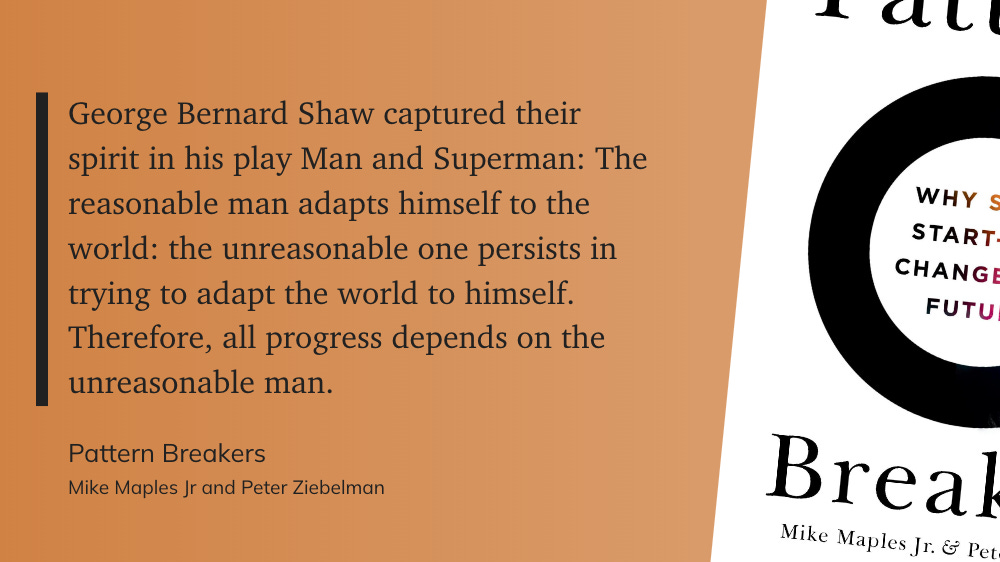The Age of Reason Is Over
So Chaos Wins?
Mike Maples Talking About his book Pattern Breakers …
Strictly speaking, the quote isn’t from Mike’s book, it was a comment he made about his book. I can’t quite recall where. But it resonated.
Not only that, it sparked another instalment in the ‘Structured Thought’ series. It’s arguably a bit of a detour:- less motorway, more a winding B-road through the mountains with great views over the lakes and useful terrain to explore.
Why the diversion?
Because I’ve been reflecting on responses to the earlier pieces (that have been appearing in various places across the inter webs, like here). Generally, people have loved the direction, but a few got tangled in that word ‘structure’. As if ‘structure’ was the point. And ‘thought’ a ‘decorative flourish’. So lets get this out on the table …
1] ‘Structured Thought’ is not about rigid form
It’s about thinking, questioning and making sense. And then on occasions, letting go of the structure. Entirely.
2] Success ≠ Following the Plan
Mike’s quote triggered an old favourite from Dwight D. Eisenhower ..
“Plans are useless, but planning is indispensable.”
In other words, decades before Mike and I were even born, 'Dwight' was reminding us that success doesn’t come from sticking to a perfect blueprint.
He was pointing to the importance of adaptation over strict, uncompromising structure.
Dwight was right.
And yet, in business, we still cling to structure as if it guarantees results and so we continue to roll out our plans, org charts, operating models, KPIs, governance frameworks, job descriptions, approval chains, sales methods, dashboards, checklists, project plans, gantt charts … you know what I am talking about!
The ‘Age of Reason’ Was Comfortable
During the ‘Age of Reason’, we:
measured what we could and convinced ourselves it meant something.
trusted what we could see and called it clarity.
valued what we could explain and mistook it for understanding.
built logical systems and assumed the work would follow.
ignored contradictions and rewrote the story to fit our beliefs.
For a while, it worked. Or at least, we believed it did, so we built maps and models describing what we found.
(Side thought, have you ever taken a close look at maps from medieval times?)
(Beautiful for sure - but ‘orientation’ wasn’t their prime objective. That would be ‘symbolism’. Maybe history does rhyme?)
In short, we built the illusion that we could manage complexity by taming it.
When you walk through a U.S. city and witness streets disappearing up steep hills, sometimes even stopping at a 'rock' face and then continuing at the top - all to preserve the 'integrity of the grid' and then you come to realise that the one street in town with a few gentle curves is now a tourist destination … it all snaps into place.
I would argue that we need to define what we mean by progress. Look around the world in 2025 and there are plenty of ‘unreasonable people’. I am far from convinced that they are moving us forward - which is a very common meaning of ‘progress’. But heh ho … because it gets worse.
AND … Just as we sought to tame our landscapes, we built entire industries around flattening complexity - resulting in
Books that promise 'The Ten Things Every Leader Must Do'
Methodologies claiming to ‘deliver’ and
Frameworks insisting that your success is 'just a checklist/course/YouTube subscription away' …
The real world refuses to play by those rules
But the cracks are showing. The rules have changed and the ground we’re standing on is shifting.
To Be Clear : What We Measure Should Matter
That’s not to say we throw the baby out with the bath water. No. It’s just that we need to reassess the terrain, because although we are beginning to understand that what we had and were doing is not enough, we’re still clinging on to the wrong things and applying old thinking to these new concepts. So we end up tracking what’s easy and ignoring what’s essential.
Take skills
We love to talk about the shift from hard skills to soft skills. But here’s the thing:
Hard skills are not called ‘hard’ because they’re difficult. They're called hard because they are tangible and tangible things are (relatively) easy to teach, easy to measure, and easy to stack on a résumé, so others can judge your capability. Perfect in a world of reason.
Soft skills are called ‘soft’ because they are the opposite. They are pretty intangible. When we think of soft skills we are typically viewing from the other end of the telescope and describing a feeling post outcome. They also don’t fit neatly into a spreadsheet and we certainly have no clue how to measure them properly. Like art - it’s as if we'll know 'em when we see 'em - and that's good enough …
G O O D G R I E F ... N O❗️
Hard skills come with degrees, certifications, deliverables. We know how to validate them. We built entire systems around doing exactly that.
Soft skills, like empathy, psychological safety, adaptability, active listening, resilience, humility, and trust don’t behave that way.
And this isn’t a new thought. How many times have you heard the comment that the doctor might be very skilled at what he does - but oh my - 'his bedside manner'.
Soft Skills are contextual, relational and invisible … until they’re missing. They are the invisible infrastructure of great teams. Not the structure. Not the strategy decks. They are the human glue.
But because we haven’t been able to see them, they have until now largely been ignored BUT, now that they are finally being recognised - it's getting worse - before it gets better.
They are seen as important by more and more people, BUT the ‘old school’ is still in charge. So they start by ignoring, head in the sand - until they finally accept that the dam has burst and set about managing them in the same way as they manage everything else - shoving them into old frameworks built for a different world.
Jason Fried once wrote about humanity’s natural tendency to interpret and handle something new using the mental models, processes, and constraints we already know - rather than developing entirely new approaches from scratch.
It’s why we talk about the horsepower of cars.
Why so many websites are referred to as digital brochures.
Why early television looked like filmed stage plays.
Why remote work started - and essentially remained - as 'office culture on Zoom'.
We default to the familiar, even when it no longer fits, copying the form without questioning the function - and as a result we often miss what the new thing actually makes possible.
We continue to use tools from the 'Age of Reason' to navigate the 'Age of Experience'.
I will let this one ‘marinate’ and in ‘part two’, I will pick up the thread and offer a way to move forward by designing systems that adapt, sense, and actually work in the real world. We’ll shift from recognising the problem to exploring what actually works in these modern times and discover that where structure flexes, leadership listens, and real work happens between the lines.
If you can't wait - you know where to find me. Who knows, our conversation might influence the next instalment.






Nice read and see our new book on make meaningful culture that expands on much of this. Thanks.